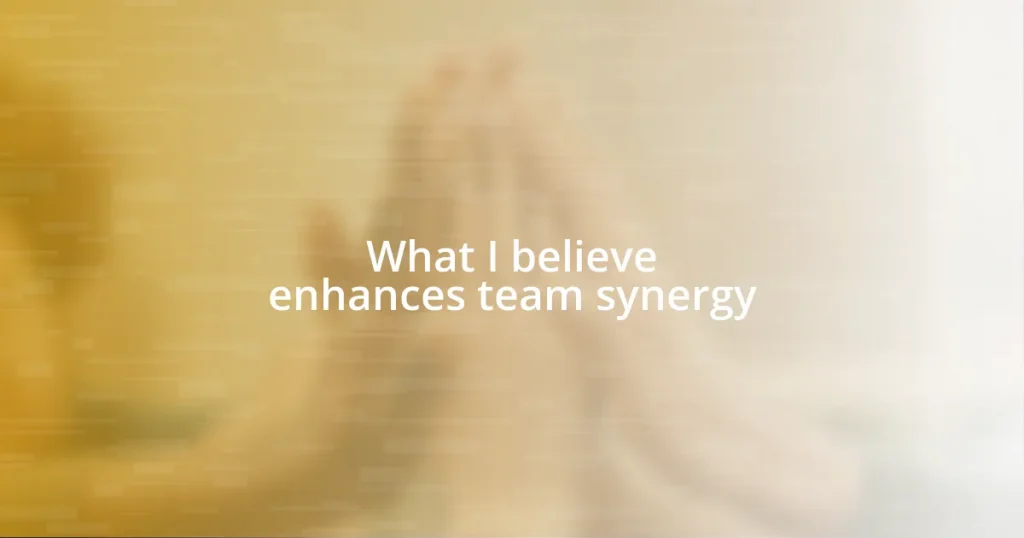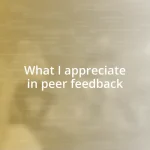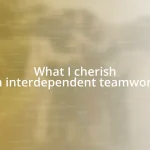Key takeaways:
- Team synergy enhances collaboration by leveraging diverse skills and clear communication, fostering a supportive environment.
- Building trust among team members through shared experiences and consistent reliability encourages open communication and risk-taking.
- Implementing collaborative decision-making strategies, like consensus-building, enhances engagement and commitment within the team.
- Continuous improvement through regular feedback and reflection is essential for team growth and adapting to challenges.
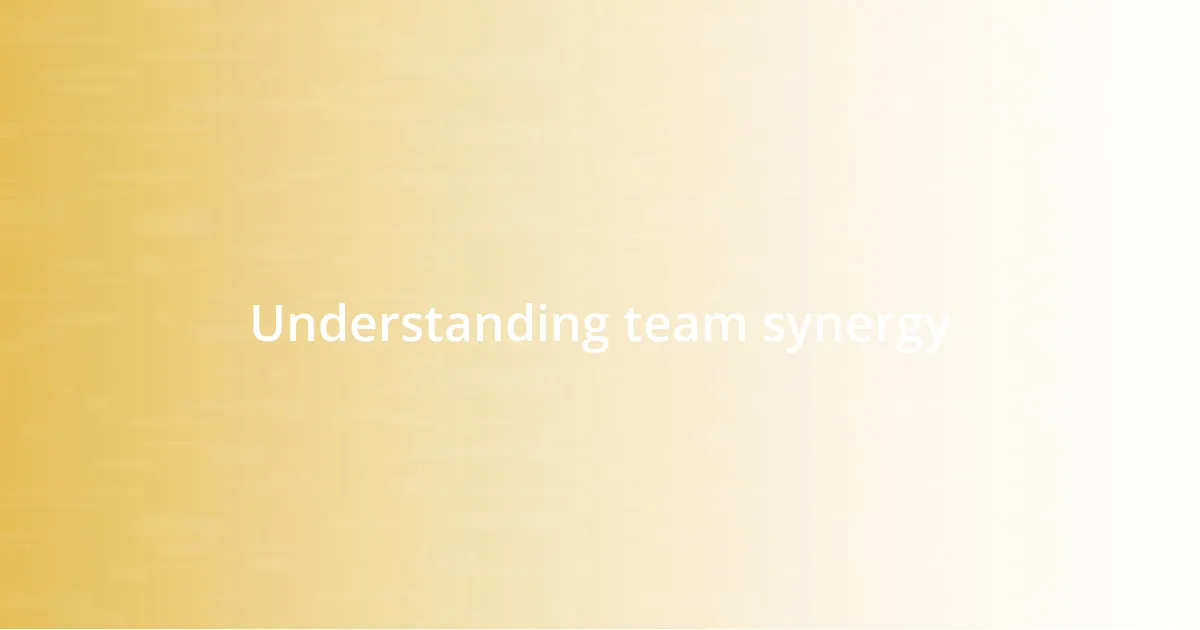
Understanding team synergy
Understanding team synergy is an intricate process. It’s not just about working together; it’s about harnessing each person’s strengths to create something greater than the sum of its parts. I often think about the project I worked on last year. We were a diverse group, each with unique skills. It felt magical when we brought our ideas together and created strategies that none of us could have achieved alone.
Have you ever experienced that moment when everything just clicks? That’s synergy. When team members communicate openly, trust each other, and align their goals, an electric energy fills the room. I remember a brainstorming session where ideas were flowing like water. The enthusiasm was contagious, and suddenly, the once-daunting challenge seemed not only achievable but exciting.
At its core, synergy fosters a supportive environment where collaboration flourishes. I’ve seen teams falter because of miscommunication or lack of trust. It reinforces my belief that team synergy is a delicate balance; it thrives on mutual respect and shared goals. Without these, it’s hard to build the kind of camaraderie that leads to innovative solutions and lasting impact.
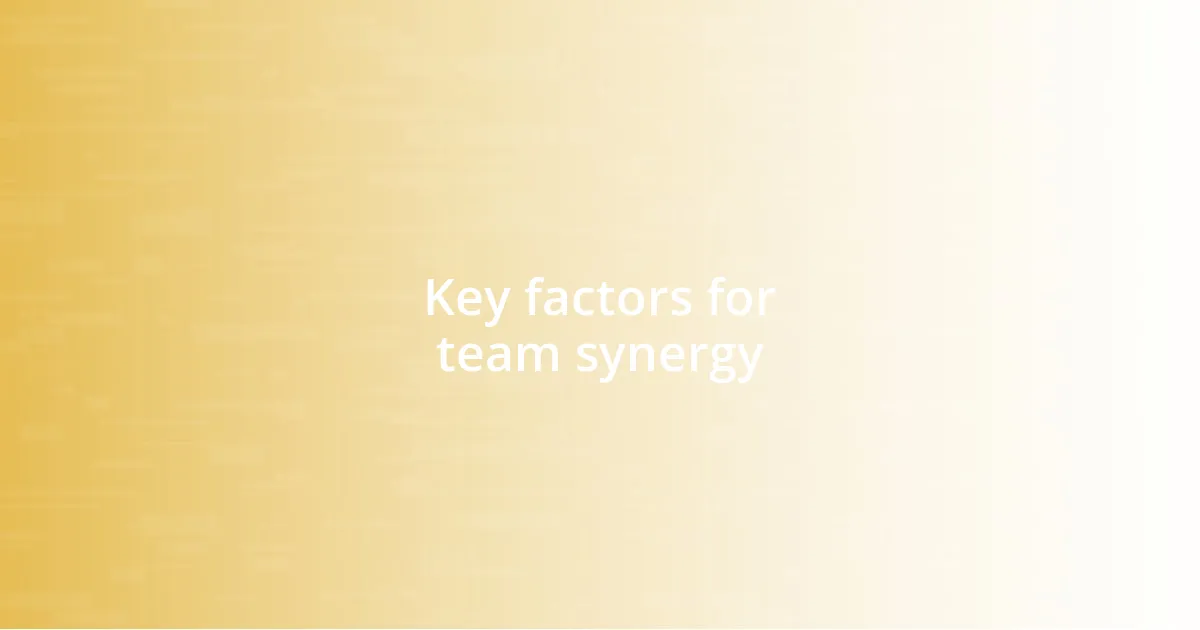
Key factors for team synergy
Creating effective team synergy hinges on several key factors that elevate collaboration. One fundamental element is open communication. I recall an instance in a past project where we adopted daily stand-up meetings. The transparency and regular check-ins allowed us to share challenges and celebrate small wins together. It created a genuine atmosphere of support and trust that really boosted our performance.
Here are some essential factors that contribute to team synergy:
– Clear Goals: Establishing shared objectives helps align every team member’s efforts.
– Diversity of Skills: A mix of talents and perspectives fosters creativity and innovative thinking.
– Trust and Respect: Building mutual trust encourages risk-taking and opens up more meaningful discussions.
– Positive Reinforcement: Celebrating achievements, no matter how small, can enhance motivation and morale.
– Conflict Resolution: Addressing disagreements proactively ensures the team remains cohesive and focused.
Each of these components plays a vital role in creating a robust environment where team synergy can truly flourish.
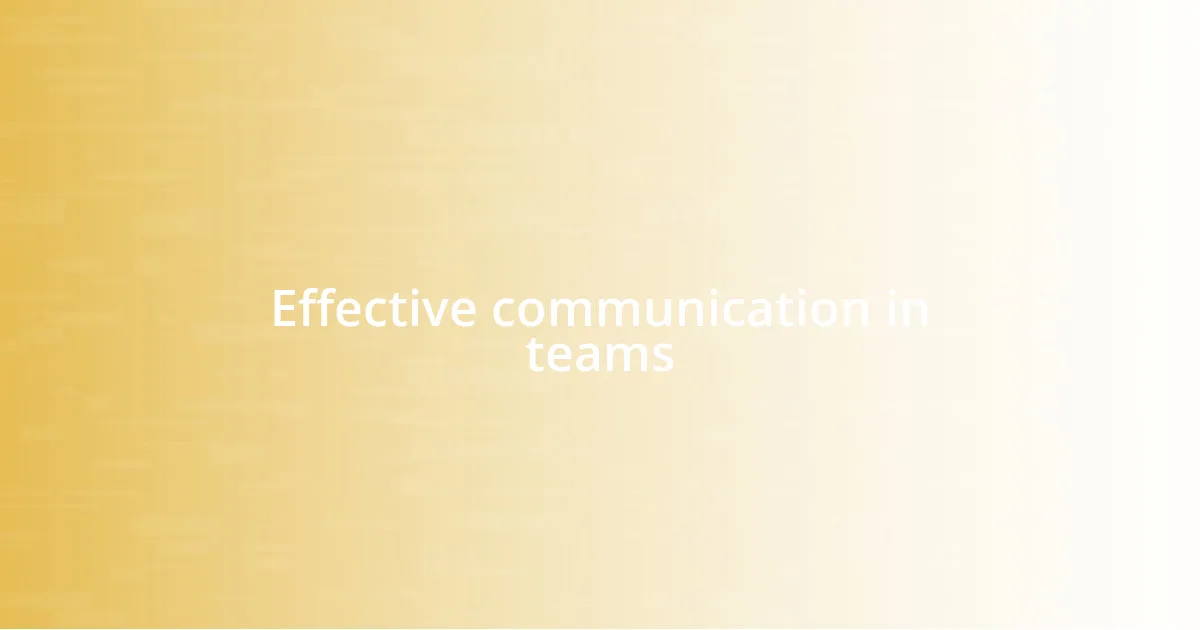
Effective communication in teams
When I think about effective communication in teams, I remember a project where we faced serious challenges. One day, during a heated discussion, I decided to step back and really listen to my teammates. By allowing their voices to be heard, we discovered different angles to the problem that we hadn’t considered before. This experience taught me that taking the time to listen is just as important as sharing your own thoughts. It’s that blend of speaking and listening that unlocks real collaboration.
Throughout my career, I’ve encountered various teams, and it’s clear that the most successful ones leverage open dialogue. For example, during a particularly demanding deadline, we created a safe space where everyone felt comfortable sharing concerns. This led to quick resolutions and reduced stress across the board. I believe that if team members are encouraged to express their thoughts without fear of judgment, it can transform the team’s dynamics. We often underestimate how powerful genuine communication can be.
Reflecting on these experiences, I find that communication in teams isn’t just about exchanging information; it’s about building connections. When we regularly check in with each other, it cultivates a sense of belonging and strengthens our resolve. In my opinion, these connections often lead to more creative outcomes. Sharing stories and insights brings humanity into our work, making even the toughest projects feel light-hearted and achievable.
| Aspect | Effective Communication |
|---|---|
| Listening | Promotes understanding and teamwork |
| Openness | Encourages everyone to share thoughts safely |
| Connection | Builds trust and a sense of belonging |
| Regular Check-ins | Keeps everyone aligned and mitigates stress |
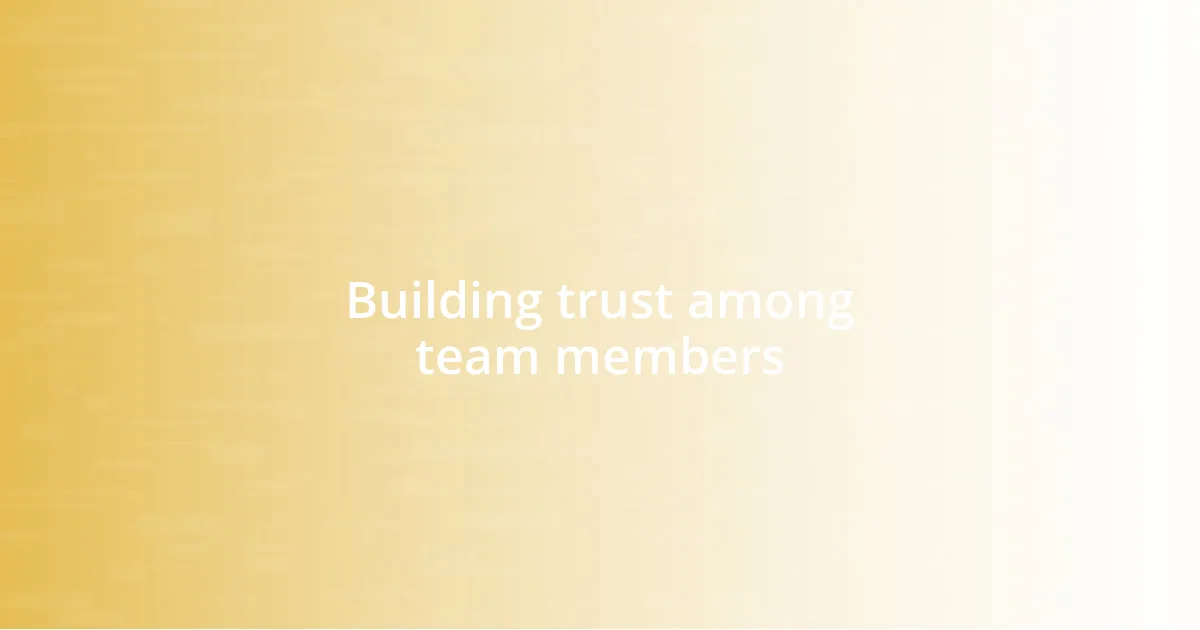
Building trust among team members
Building trust among team members is an essential pillar of synergy. I remember one time in a collaborative project, we organized a fun team-building day. It was surprising how a few hours of shared experiences—like tackling an escape room together—led to moments of laughter and vulnerability. That day, barriers came down, and we began relying on one another more openly. Isn’t it fascinating how shared experiences can cultivate trust in such a short time?
In my view, trust doesn’t just magically appear; it’s built gradually through consistent actions. I once had a colleague who always followed through on her promises. This reliability made me feel secure sharing my ideas and challenges with her. When team members see each other as dependable, it creates a circle of trust that encourages risk-taking and healthy discussions. Can you recall a time when you felt comfortable taking a risk in a team? That comfort often stems from knowing your peers will support you.
Establishing an environment where everyone feels valued is critical. In one memorable project, we celebrated each other’s contributions, big or small, during our weekly meetings. Even simple acknowledgments fostered a culture of respect and trust. I believe this kind of recognition not only uplifts individual morale but also strengthens the entire team’s bond. Trust is indeed a two-way street; when one person opens up, it inspires others to do the same, leading to a deeper connection that enhances overall synergy.
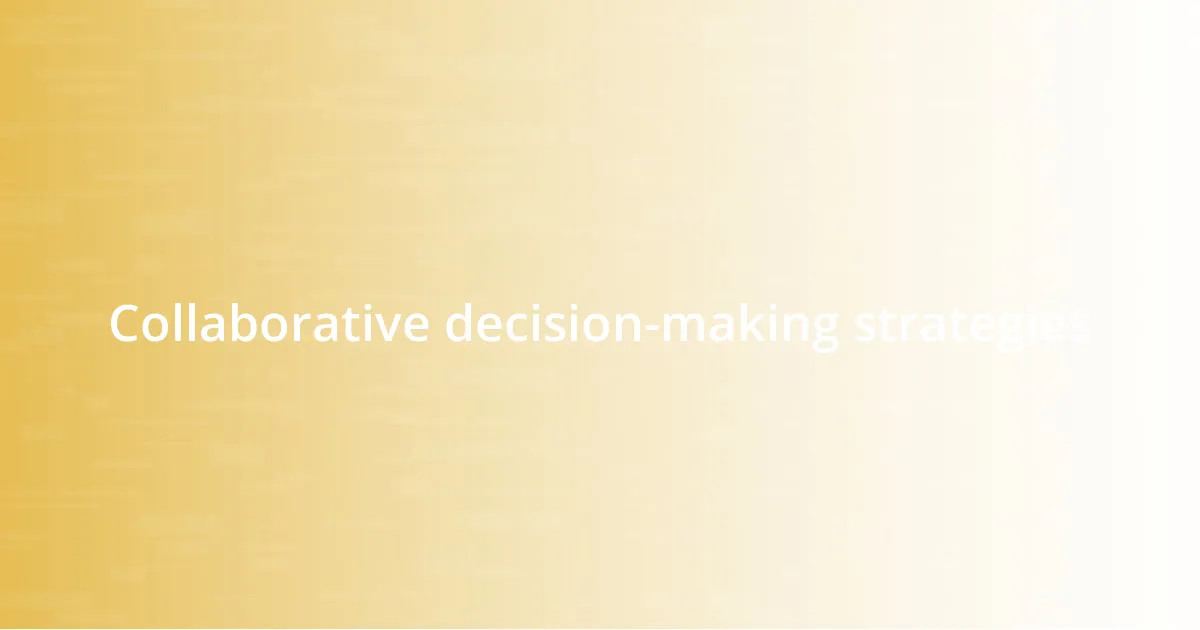
Collaborative decision-making strategies
In my experience, implementing collaborative decision-making strategies can significantly enhance team synergy. I recall a time when my team faced a critical choice regarding a project direction. Instead of having a single leader dictate the path, we held a structured brainstorming session where everyone shared their thoughts. This wasn’t just about gathering opinions; it felt like a collective dance of ideas, and the best solutions emerged organically from our combined perspectives.
Another effective approach I’ve come across is the use of consensus-building techniques. During one project, we utilized methods like dot voting, where each member could express their preferences without feeling pressured. It created an engaging atmosphere where everyone’s voice mattered. I noticed that this not only built commitment to the decision made but also sparked enthusiasm for action. Isn’t it powerful to see a team come together, driven by a unified choice?
I can’t stress enough the importance of clearly defining roles during collaborative decision-making. In one memorable strategy session, we designated specific facilitators to ensure the process remained smooth and inclusive. This structure allowed for diverse viewpoints while keeping us focused. I’ve often found that when everyone understands their role, it fosters accountability and strengthens the collaborative spirit. Have you seen how clarity can transform group dynamics? It really empowers each member to contribute confidently.
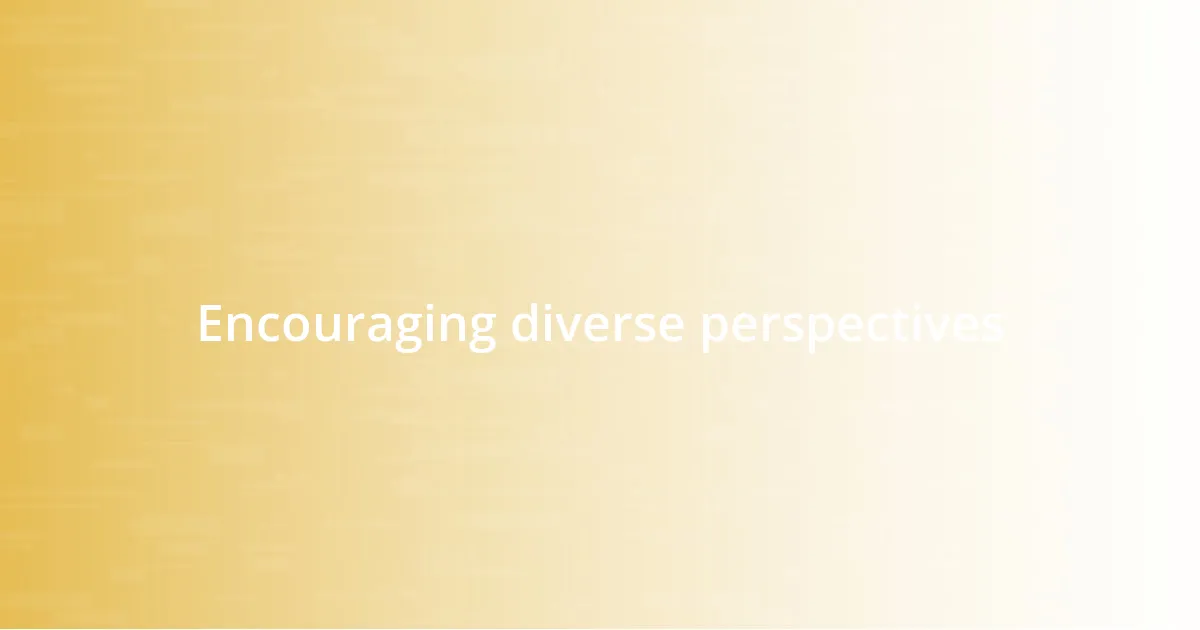
Encouraging diverse perspectives
Encouraging diverse perspectives can truly revolutionize a team’s dynamic. I remember a project where we invited a colleague from another department to join our brainstorming sessions. Her fresh point of view opened my eyes to ideas I had never considered. It felt exhilarating to see how different backgrounds and expertise brought about innovative solutions. Have you ever experienced that “aha” moment when someone thinks outside the box?
In another instance, our team hosted a “lunch and learn” series, dedicated to exploring various cultural practices and ideas. With each session, I felt our understanding deepening and my own biases challenging. The conversations that emerged were not only enlightening but also fostered a sense of camaraderie. How great is it to think that learning from each other can build stronger connections?
I firmly believe that creating a space where all voices are heard is essential. During one challenging meeting, the quietest member finally shared a perspective that shifted the entire discussion. The tension lifted, and the energy in the room transformed. I’ve often felt that when people feel safe expressing themselves, magic happens—ideas flourish, and collaboration takes on a life of its own. Have you witnessed how a simple shift in conversation can unlock potential within your team? It’s honestly rewarding to be a part of that transformation.
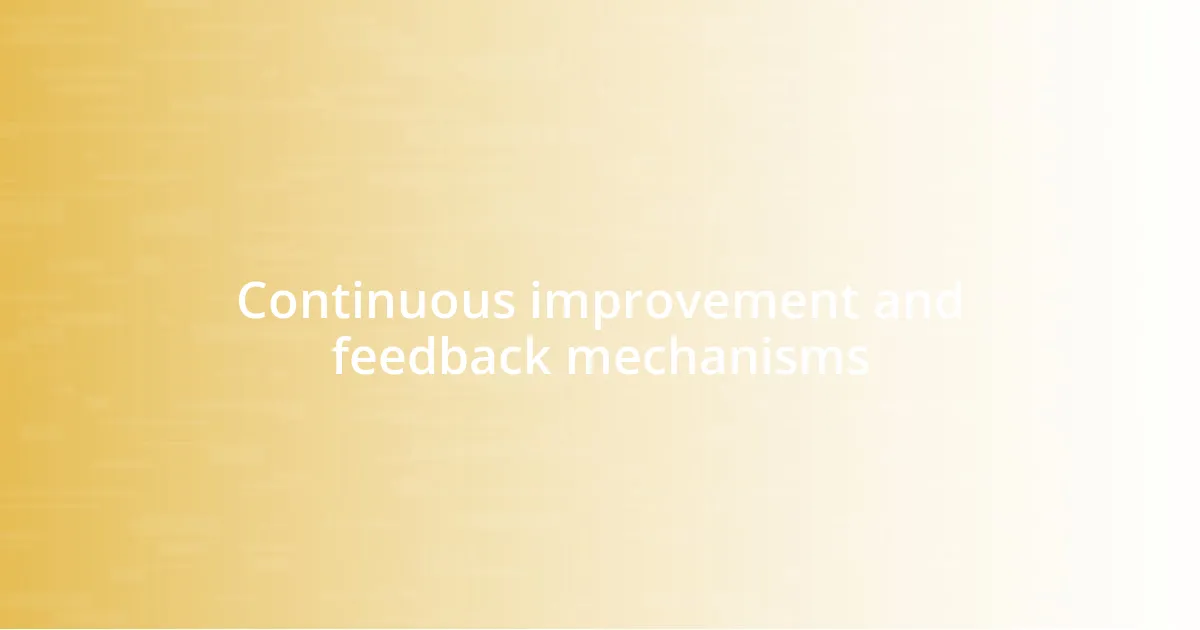
Continuous improvement and feedback mechanisms
Continuous improvement and feedback mechanisms are vital for any team aiming for synergy. I vividly recall a team meeting where we dedicated half the time to reflect on our last sprint. The open discussion transformed the atmosphere; it wasn’t about pointing fingers but rather understanding each other’s experiences and learning to grow together. Have you ever noticed how a simple feedback loop can illuminate paths to improvement that we hadn’t seen before?
In my opinion, establishing a culture of continuous feedback is like nurturing a garden. Each member can contribute insights that act as nutrients, helping the team grow. I think about a specific instance where we introduced weekly check-ins, not just for project updates but to discuss team dynamics too. During one of those sessions, I shared a thought about communication gaps I noticed, and it sparked an in-depth dialogue. This openness fostered a collective commitment to enhancing our workflow, and you could almost feel the energy shift. Isn’t it amazing how open conversations can lead to quick adjustments that benefit everyone?
Moreover, the way we act on feedback is crucial. After one major project, we compiled all the input in a shared document and made a point to address each point in our next planning session. I still remember the surprise on my teammates’ faces when we reviewed those insights together. They felt valued, knowing that their input directly influenced future decisions. Isn’t it powerful to witness a team evolve just because we took the time to reflect and adapt?










